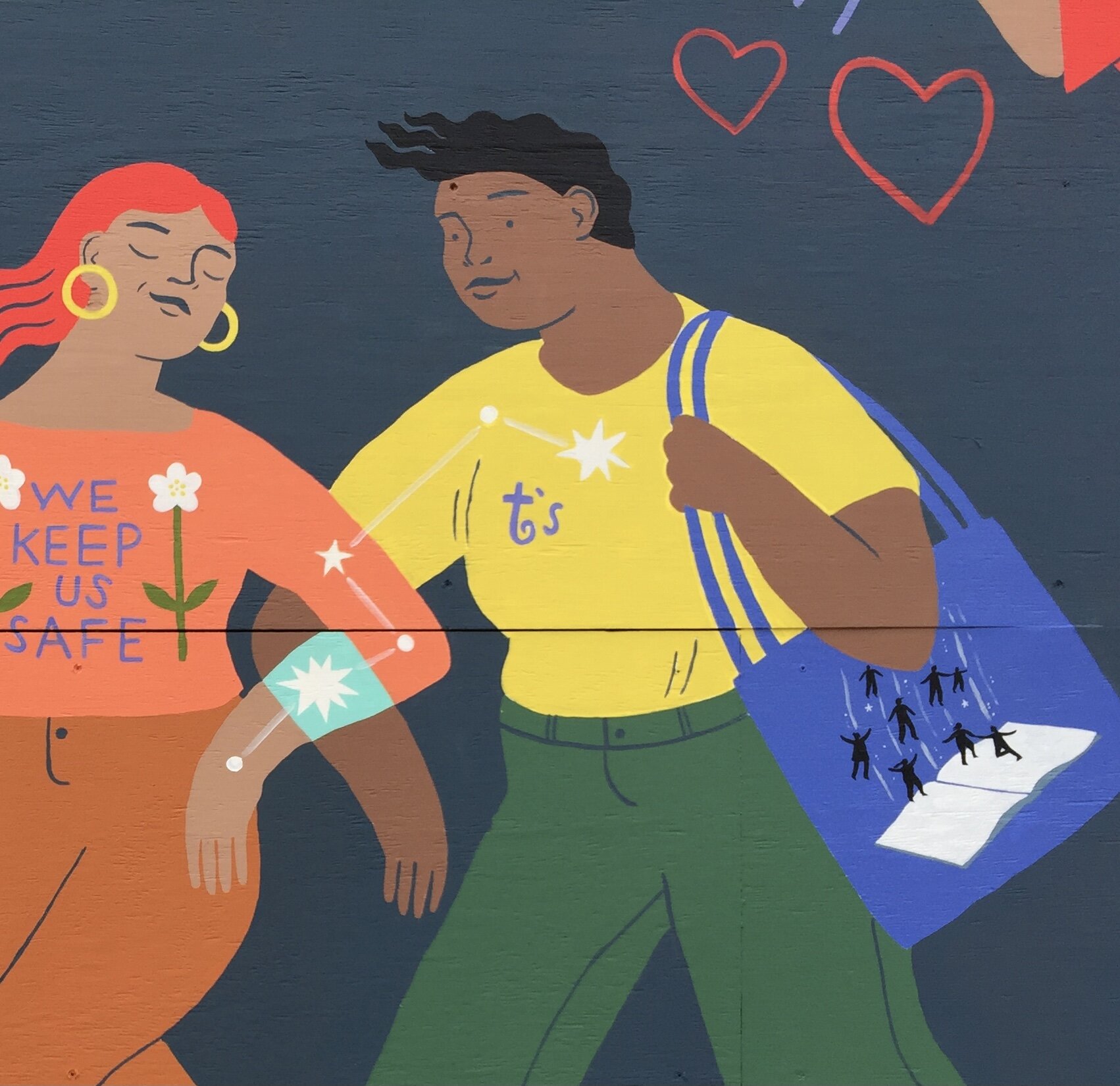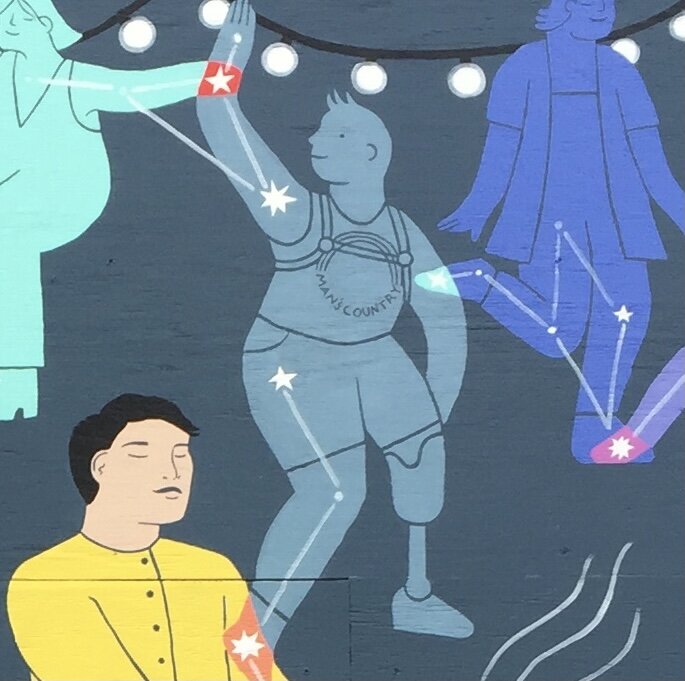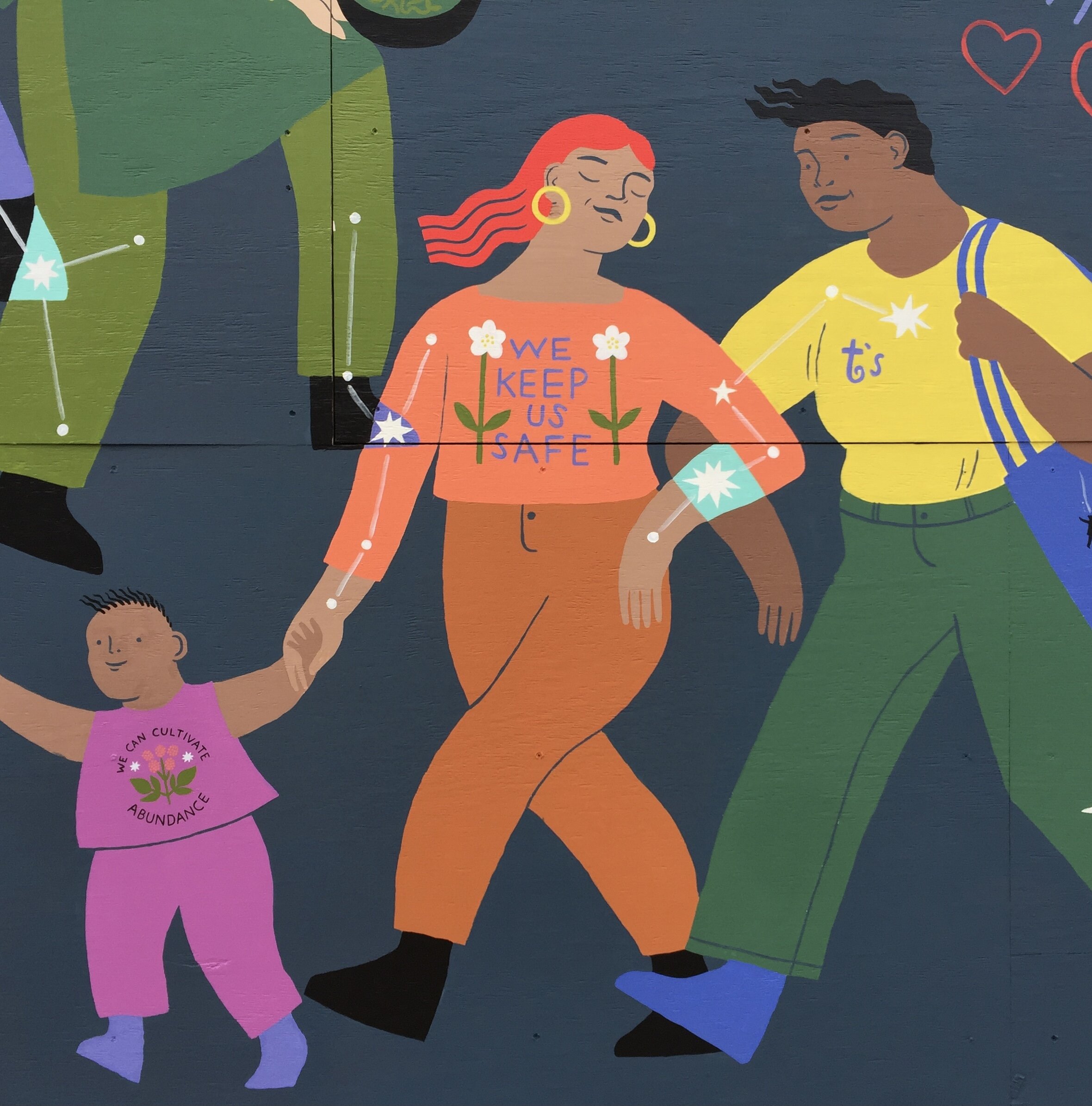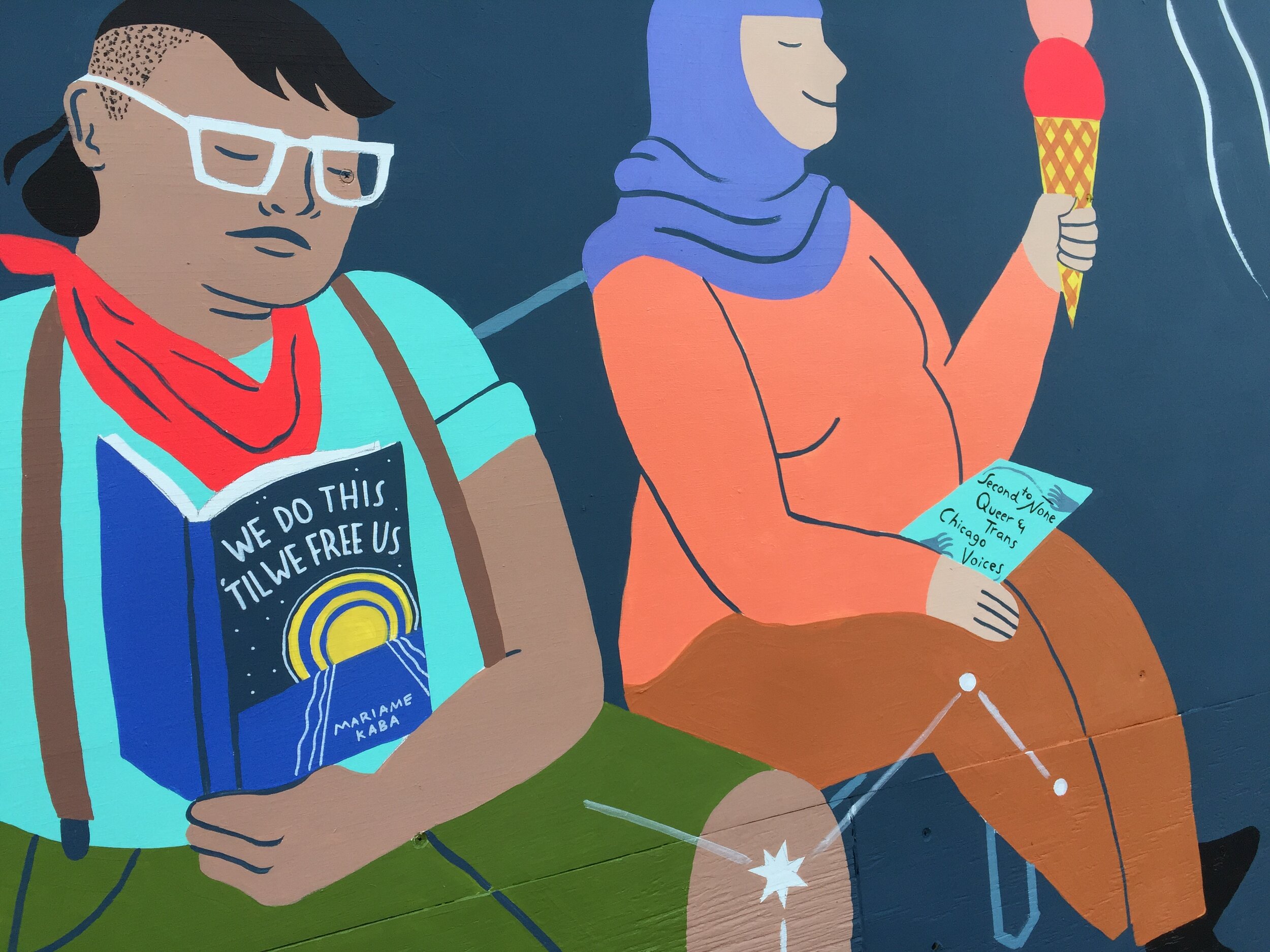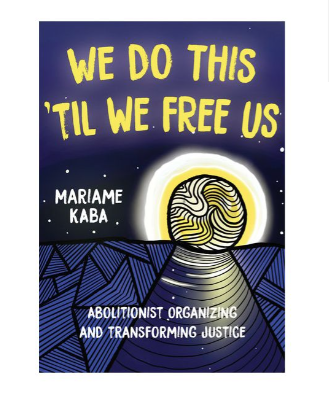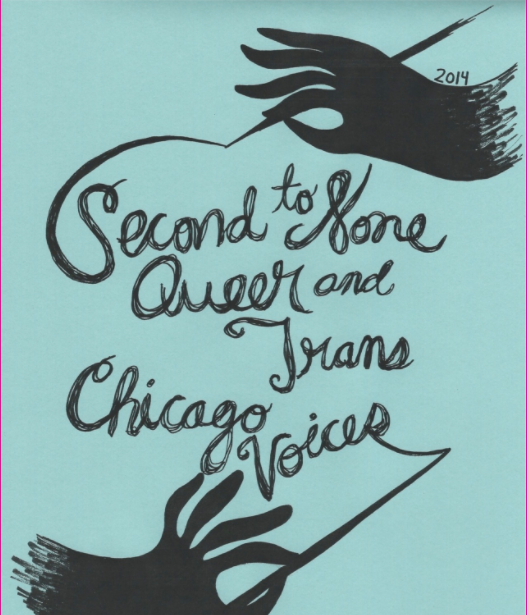"Life at the Intersections" Mural in Andersonville
This past June I completed my 4th mural just a few miles south of where I live in the Andersonville Neighborhood of Chicago. Under the direction and support of the Andersonville Chamber of Commerce I was hired to design a mural under the theme of “Identity” and to illustrate “the diverse, inclusive and robust identity of the Andersonville community, and Andersonville’s ‘Main Street’ look and feel.”
Living in Rogers Park, Andersonville has been a frequent destination for my partner and I, so I was familiar with some of its history and had my own lived experiences of walking, dining and working in the area. I also came to this project holding a keen awareness that many Trans, Black and POC resident still experience experienced racism, homophobia, and transphobia here within the boundaries of this neighborhood and even within the institutions we celebrate as progressive. I found myself asking; What does it mean to “celebrate diversity”? Who does that benefit? Does a project like this help create a safer and more inclusive space for all Black, Transgender and POC community members and visitors? I know there is no short answer to this and that genuine community safety looks like so many small and large changes to our culture, but I do know that art can help shape the direction of our future and help us imagine what those changes need to look like. It is my hope that this mural is not seen as a celebration of something achieved but rather as an invitation to our future together and a joyful recognition of the work that is ahead of us, work that is rooted in collective care and affirms the inherent worth of all Andersonville residents.
I came to this project holding this truth, these hopes and these questions and was guided by decades of queer history, creativity, imagination and resistance that has graced these streets, pushed boundaries and has helped shape Andersonville into the neighborhood that is is today. I knew I wanted to highlight this history and the visions of this community in the mural.
After about a month of research, interviews, questionnaires, visiting museums, phone calls, writing and sketching “Life at the Intersections” came to life. Utilizing a frequent design concept of mine, constellations to suggested themes of interconnectedness, and highlighting the sections where the bodies overlap, I wanted to emphasize the intersections of our identities and that our communities can thrive when intersectional approaches to business, community, and wellness are centered.
A deep deep thank you to those individuals who shared their lived experiences of working and residing in Andersonville. Their honesty about the area and hopes for the future were poured into these visuals. I hope I was able to reflect their stories and desires through this image.
Much gratitude to the Andersonville Chamber of Commerce for the enthusiastic and logistical support as well as Rae Wilson and Nell Seggerson for spending many hours in the sun painting with me!
If you would like to read the speech I gave at the Mural Dedication this past September you can read that HERE.
Below you will find more information about many of the references that included in the mural
Andersonville History
Too often when we talk about the history of the area we skip right to post-colonization. While the Indigenous History of this specific area was hard to come by, and also knowing that writing Land Acknowledgements won’t undo the histories of ongoing genocide against Indigenous People’s and Indigenous history, it did feel important to me to include an acknowledgement of Indigenous residents on the mural itself. The mural credits in the lower left corner of the installation read;
More history; Andersonville is historically know for it’s Swedish heritage. Swedish farmers started immigrating to the area in the area that is now called Chicago in the 1800’s and eventually to this neighborhood in the later half of 1800’s to the early 20th century. The former Swedish Bakery featured in the mural by the baker holding a tray of cookies, was a beloved shop for many locals. The Swedish symbol of the Dala Horse is depicted as one of the cookie options! Did you know that Andersonville was a large cherry orchard in the 1850’s?
Queer History
Just a few queer historical gathering places shouted out in the mural including T’s Bar that opened in the late 70’s and was a common spot for the lesbian community to gather. Man’s Country was Chicago’s oldest gay bathhouse that opened in 1973.
Organizing, Activism, Community Safety, Sustainability
When I was invited to design this mural I was interested in sharing stories about Andersonville that existed beyond the storefronts and the capital exchange and consumption of goods. What makes Andersonvile a neighborhood people gravitate toward? What are some of the area's strengths and challenges?
While seeking community input some of the questions I asked included; “Where do you find connection and support in the neighborhood?” “What organizations do you love?” “What do you see authentic relationships being built?” “When you imagine the future of Andersonville, what do you see?”
I received a lot of responses related to organizing that is happening in the area, folks favorite organizations, and visions of a future of Andersonville that continues to challenge white, cis, heteronormative atmospheres. Some of the work I was able to reference in the mural include;
Mutual Aid Work various orgs like Care for Real and First Slice
Anti-racism and Trans inclusive organizing
Affordable housing organizing
Sustainability such as native plant landscaping initiatives and upcoming neighborhood composting program
Alternative community Safety- we keep up safe
A few creative projects that I was inspired by include the “We Keep Us Safe” Poster Series organized by Monica Trinidad and the statement “I don’t watch my neighbors. I see them.” featured on one of Micah Bazant’s posters for the Ella Baker Center's Night Out for Safety and Liberation series.
Local Literature
A well known and popular stop for locals and visitors to Andersonville is Women & Children First BookStore. Honoring the “transformative power of literature”, this bookstore offers the area a one-stop-shop for politically progressive, LGBTQIA+ creative and nonfiction reads. I reached out to a poet and artist friend of mine H. Melt, who has worked at WCF for several years and asked about popular books coming out of the shop. I was excited to hear that “We Do This Till We Free Us” by Mariame Kaba was one of the top selling books in the history of the store! This book felt like a perfect addition to the mural since Marime used to be a Rogers Park resident and the cover was designed by a Chicago favorite artist/organizer, Monica Trinidad. I am also an Abolitionist and I know many Andersonville residents who are working toward decreasing police presence in the area and building alternative community safety models.
After thinking through what other publication might be a good fit, I was very please that H let me include one of their zine publications from 2014 “Second to None: Queer and Trans Chicago Voices”. This zine includes a “collection of essays (mostly originally online), documenting a critical queer, nonfiction literary voice that is strongly rooted in Chicago.” To check out more of H.’s work, visit their website HERE. To learn more about “Second to None” check out this write up HERE. This zine is also archived in Read/Write Library archives & U Chicago Special Collections.
New Pride Flag
The flag I included on the mural, New Pride Flag, was designed and painted by Julia Feliz a gendervague, pansexual, Black and Indigenous native Puerto Rican. “New Pride Flag is a 501(c)(3) centering the LGBTQIA’s most marginalized by fundraising, raising voices, education, and advocacy for the rights, protection, and safety of Trans and Queer Black, Brown, and Indigenous People of MaGe (marginalized genders). To read more about this project or to buy a flag, visit the website HERE.
Other References
A few other references include; the Andersonville Farmers Market, Puppet Bike, local architectural designs, and a handful of restaurants. Can you guess what they are?







